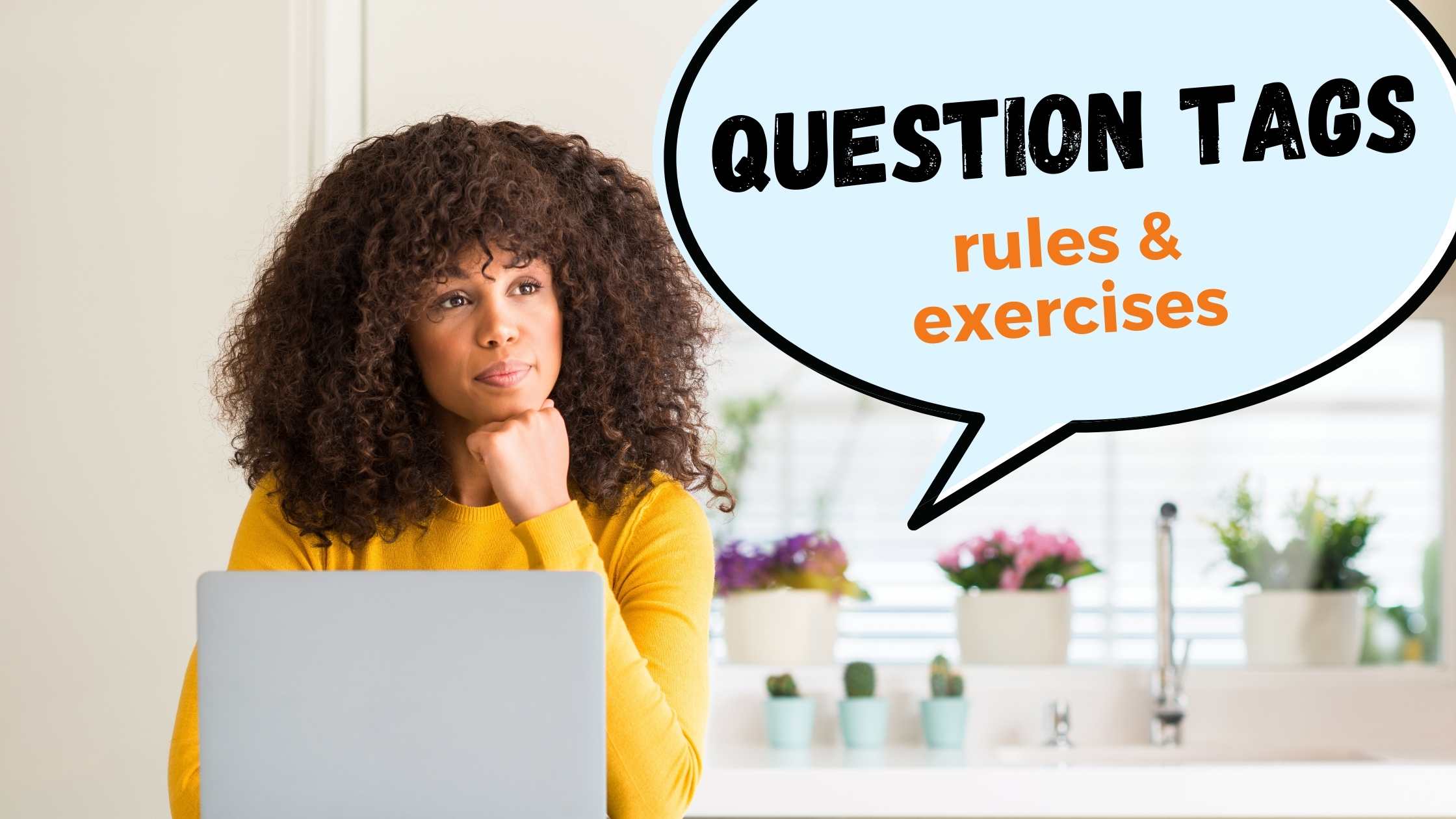Question Tags: How to Ask for Confirmation in English, plus Exercises
You know what questions tags are, don’t you? If you have never heard of this before, go back to the first sentence of this blog post. The clause don’t you? is what we call a question tag. There are positive tags and negative tags. Keep reading to understand the difference between them.
These types of question help us ask for confirmation. However, there are several rules you should know in order to use question tags correctly. They can be super helpful for any English learner, so keep reading this blog post for more information about them.
What are question tags?
Most questions start with a WH question word or a verb like do, doesn’t, is, are, etc. These are punctuated with a question mark (?).
However, some questions can be written like a normal sentence, with a little something extra added at the end. This is called a question tag. It is a short clause (a clause is a group of words) that we add to the end of a sentence with either one of these purposes:
- to confirm that something is true
Example: They are married, aren’t they? - to encourage the person we are having a conversation with to give us a reply
Example: That is a brilliant idea, isn’t it?

A question tag is similar to asking something like Am I right? or Do you agree with me? after a sentence. It is important to mention that question tags are also called tag questions.
The structure of a question tag
In this section, you will learn how to form a question using a tag. Remember, the tag is always at the end of the sentence. The question in this form has two important parts: the sentence and the tag.
A question tag is special because the two parts are opposites. They are like magnets with a positive end and a negative end. If we have a positive sentence, we need a negative tag. However, if we have a negative sentence, we add a positive tag to it. Look at the examples below:
- She is your sister, isn’t she?
Positive sentence: She is your sister
Negative tag: isn’t she?
- Luke doesn’t have kids, does he?
Negative sentence: Luke doesn’t have kids
Positive tag: does he?

[convertkit form=2182327]
Positive tags
Now, let’s take a look at the rules for forming the positive tags. Remember: a negative sentence asks for a positive tag. Read more about the difference between simple past and present perfect here.
Verb Tense Negative Sentence Positive Tag To Be He isn’t American, is he? Simple Present Lucy doesn’t like to drive, does she? Simple Past Kelly didn’t go to class, did she? Past Continuous Paul wasn’t cooking dinner, was he? Present Perfect You haven’t been to Canada, have you? Future (Will) She will not come to the party, will she? Future (Going to) Joanna isn’t going to the doctor tomorrow, is she? Modal Verbs Julie can’t drive, can she?

Negative tags
Now, let’s take a look at the rules for forming the negative tags. Remember: a positive sentence asks for a negative tag.
| Verb Tense | Positive Sentence | Negative Tag |
| To Be | Sarah is tall, | isn’t she? |
| Simple Present | They like pizza, | don’t they? |
| Simple Past | They went to the party, | didn’t they? |
| Past Continuous | They were making pizza, | weren’t they? |
| Present Perfect | He has worked there for 5 years, | hasn’t he? |
| Future (Will) | We will go home, | won’t we? |
| Future (Going to) | They are going to Paris, | aren’t they? |
| Modal Verbs | He can speak English, | can’t he? |

Yes, she is flying there tomorrow.
Intonation
There are two possible kinds of intonation in question tags: the rising intonation and the falling one. We use the rising intonation when we are not sure about what we just said. It’s a way to ask for clarification. Meanwhile, the falling intonation is used when we are pretty sure about our statement and just want somebody else to confirm our thoughts.
Exceptions
Almost all question tag situations follow the rules from the tables above, but of course, there are a few exceptions! That’s the nature of English, isn’t it?
1. When we use the expression Let’s, the question tag is always shall we?
If the sentence part of your question tag starts with “Let’s”, you should use “shall we” as the tag.
Here are some examples:
- Let’s go to the party, shall we?
- Let’s get to work, shall we?
2. When a sentence starts with I am, the question tag must be aren’t I?
If you use the first-person singular in the present tense (read: I am) for the sentence part of your question tag, you should use aren’t I as the tag. Take a look at this sentence:
- I am late, aren’t I?

3. Imperatives and question tags
An imperative is a sentence that starts with an action verb. They are used a lot for instructions. You might hear a teacher or a boss talk with imperatives.
Imperative examples:
- Sit down.
- Bring that to me.
Whenever we have a sentence in the imperative, the tag needs to be will you / would you / or won’t you? You can choose which tag to use.
Here are three examples:
- Pass me the sugar, will you?
- Close the door, would you?
- Sit down, won’t you?
4. Negative words, such as nobody, never, no, and hardly, need positive tags
Negative words need positive tags. These are words like nobody, never, no, hardly, etc. Also, for words like nobody, everybody, and somebody, the question tag should be they. Take a look at some examples:
- Nobody wants to go home, do they?
- We have never been to your grandma’s house, have we?
[fusion_fusionslider name=”english-courses” full_height=”no” offset=”” hide_on_mobile=”small-visibility,medium-visibility,large-visibility” class=”” id=”” /]
Pratice time
Check your understanding with the exercises below. Have fun!
Exercise 1 – Drag the words
Exercise 2 – Fill in the blanks
We use question tags every day, don’t we? Being able to use them correctly is essential for any English learner. We hope this blog post is helpful to you. For more information, check out this video about question tags. Let’s study, shall we?

